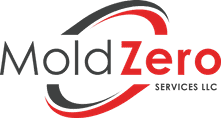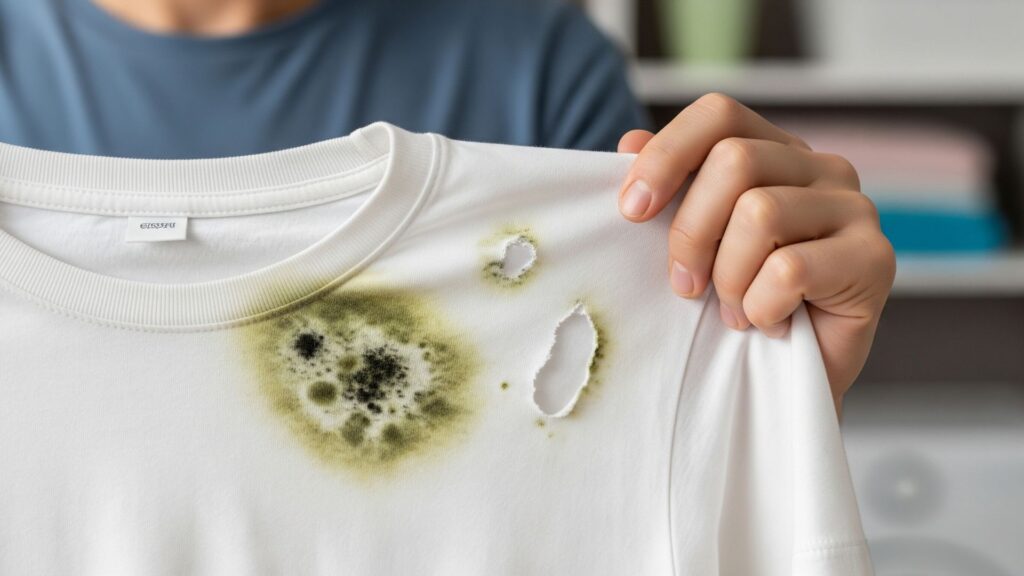How to Address Mold on Clothes: A Guide for Homeowners
Understanding the Discovery
Finding spots of mold on your favorite shirt or detecting a persistent musty odor in your closet can be unsettling for any Los Angeles homeowner. This discovery often leads to a critical question: can you get the mold out of clothes, or is it time to throw them away? While some garments can be salvaged with the right approach, it’s crucial to recognize that mold on fabric can sometimes be a symptom of a much larger issue lurking within your property. At Mold Zero, with our experience across more than 1,000 properties, we understand the connection between affected belongings and the overall condition of your indoor environment. This guide will help you assess the situation, provide steps for addressing minor issues, and clarify when it’s time to call in professional help for a comprehensive solution.
Mold vs. Mildew on Clothes
Though often used interchangeably, mold and mildew are different types of fungi. Mildew is typically a surface-level fungus that appears as a powdery patch of gray or white. It’s easier to address because it doesn’t penetrate the fabric as deeply. Mold, on the other hand, is often fuzzy or slimy in texture and can appear in shades of green, black, or other colors. It has a stronger root structure that can grow deep into the fibers of your clothing, causing more significant material alteration and a stronger, more persistent odor. Recognizing which one you’re dealing with is the first step in deciding your course of action.
Identifying the Scope of the Problem on Your Fabric
Visual Cues and Telltale Odors
The most obvious sign is seeing the growth itself. Look for fuzzy spots, discoloration, or slimy patches on the fabric. However, the most common indicator that prompts homeowners to investigate is the distinct musty smell in clothes. This odor is produced by the metabolic processes of the fungus as it grows and consumes organic material. If your clothes smell musty even after being washed, it’s a strong signal that the fungal growth hasn’t been fully addressed and may be deeply embedded in the fibers or that the storage environment itself is the source of the problem.
When a Small Spot Signals a Big Issue
A single spot of mildew on a towel left damp in a gym bag is one thing. But discovering widespread mold on clothes in your closet is a significant red flag. If multiple garments, shoes, and other stored items are affected, the problem isn’t the clothes themselves; it’s the environment they are in. This situation points toward a systemic moisture or humidity issue within your home that requires immediate and professional attention to prevent further property impact.
What Causes Mold on Clothes in a Closet?
The Critical Role of Moisture and Humidity
Mold needs three things to thrive: a food source (the organic fibers in your clothes), a suitable temperature, and, most importantly, moisture. Closets are often ideal breeding grounds because they are dark, enclosed spaces with limited air circulation. The primary cause of mold on clothes in a closet is excess humidity. This can stem from several sources, including putting away clothes that are not completely dry, a slow plumbing leak in an adjacent wall, poor ventilation throughout the home, or the general high humidity common in coastal areas like Los Angeles. Without proper airflow, this moisture gets trapped, raising the humidity inside the closet to levels that support fungal growth.
Improper Storage and Environmental Factors
How you store your clothes also plays a significant part. Packing garments too tightly prevents air from circulating between them, trapping any moisture present. Storing seasonal clothing in cardboard boxes or non-breathable plastic containers in a garage or basement can also lead to problems, as these areas are prone to temperature fluctuations and dampness. Cardboard readily absorbs atmospheric moisture, creating a perfect environment for mold to grow and transfer to your belongings. For long-term storage, it’s essential to use clean, dry containers in a climate-controlled part of your home.
A Practical Guide to Get Mold Out of Clothes
Deciding if an Item is Salvageable
Before you begin, assess the item. Is it a washable fabric like cotton or a synthetic blend? Or is it a delicate material like silk, wool, or leather that requires special care? The methods below are intended for durable, washable fabrics. For valuable, delicate, or non-washable items, attempting to address the mold on fabric yourself can cause irreversible alteration. Furthermore, if the mold is extensive and covers a large portion of the garment, or if the fabric appears weakened or deteriorated, it may be best to discard the item.
Steps for Addressing Minor Mold on Fabric
For minor, surface-level spots on sturdy clothing, you can try a few methods to address the issue. These techniques are most effective on fresh spots of mildew on clothes and may require multiple attempts. We recommend performing these steps in a well-ventilated area or outdoors to avoid dispersing spores inside your home.
- First, take the affected clothing outside and brush off as much of the loose surface mold as possible. Doing this outdoors prevents the spores from becoming airborne inside your house. Use a soft-bristled brush and be gentle to avoid working the mold deeper into the fabric.
- Next, you can pre-treat the stained area. A solution of equal parts white vinegar and water can be effective. Apply it to the spot or soak the entire garment for at least one hour. Alternatively, a paste made from baking soda and water can be applied directly to the stain.
- After pre-treatment, wash the garment in the washing machine using the hottest water setting that the fabric care label permits. You can add a cup of white vinegar or a half-cup of borax to the wash cycle along with your regular detergent to help address any lingering issues.
- Finally, drying is a critical step. If possible, dry the clothing in direct sunlight. The UV rays from the sun can help address any remaining fungal traces. Make absolutely certain the item is completely dry before storing it. If a musty smell in clothes persists after washing and drying, repeat the process.

When Moldy Clothes Indicate a Bigger Problem
Your Closet is a Barometer for Your Home’s Condition
Finding mold on a few items is an annoyance. Finding it on many items, or having it return shortly after cleaning, is a clear warning sign that you have an underlying environmental issue in your home. The clothes are not the source of the problem; they are the symptom. The real issue is likely excessive ambient moisture or a hidden mold colony growing within your walls, ceiling, or flooring. This is especially true if you notice a persistent musty odor in the room even when the closet is empty. This is the critical point where you must consider when moldy clothes indicate a bigger problem that requires professional intervention.
Signs You Need a Professional Mold Inspection
If you’re a homeowner or landlord in Los Angeles or San Marino, it’s vital to recognize the signs that DIY methods are insufficient. Contact a professional if you observe any of the following:
- Mold growth on multiple articles of clothing, shoes, and other stored belongings.
- A strong, persistent musty odor that lingers in a room or closet.
- Visible signs of mold growth on the walls, ceiling, or baseboards of the closet or adjacent rooms.
- You’ve recently experienced a water event, such as a pipe leak, roof leak, or flood.
- The problem with mold on fabric returns quickly after you’ve cleaned the items.
Ignoring these signs allows the underlying issue to worsen, potentially impacting your property’s structural components and indoor environment. Don’t wait. Call Mold Zero at (626) 671-8885 for a free, no-obligation inspection.
Mold Zero: Your Partner for Property and Item Mold Issues
Why Our Comprehensive Process is the Definitive Solution
When you’re facing a systemic mold issue, you need more than a surface-level fix. At Mold Zero, our NORMI Certified professionals utilize a unique 5-step process that is fast, minimally invasive, and exceptionally thorough. Unlike traditional methods that can involve extensive demolition, our approach addresses the root of the problem efficiently, often in just hours, not days. We address both surface and airborne mold, resolving the issue at its source to ensure it doesn’t return. With experience from over 1,000 successful remediation jobs, we have the expertise to handle any situation with precision and care.
Our Commitment to Your Well-being and Peace of Mind
We built our company on a “Family First” philosophy. This means we use solutions and processes that we would trust in our own homes, always prioritizing the well-being of your property and its occupants. We stand firmly behind our work, which is why we offer an unmatched 1-Year Guarantee against the return of new mold growth. This guarantee provides you with the confidence and peace of mind that you’ve chosen the right partner to protect your property investment.
Unbiased, Third-Party Verification You Can Trust
Trust is paramount when dealing with mold. That’s why we don’t just tell you the problem is resolved—we prove it. After our process is complete, we bring in an independent, third-party laboratory to conduct post-treatment testing. This unbiased verification provides concrete data confirming the success of our work, giving you absolute certainty in the results. This commitment to authoritativeness and transparency is what makes Mold Zero the trusted mold remediation expert in Los Angeles. If you need professional help for item mold or suspect a larger issue, contact us immediately.
Take Action to Protect Your Los Angeles Property
A musty closet filled with moldy clothes is more than just a laundry problem; it’s a clear signal from your home that something is wrong. Ignoring it can lead to more significant issues down the line. Protect your property, your belongings, and your peace of mind by addressing the problem at its source. For a fast, guaranteed, and verified solution, contact the experts at Mold Zero. Call us today at (626) 671-8885 or fill out our online form to schedule your free mold inspection in Los Angeles county and receive a detailed quote.

